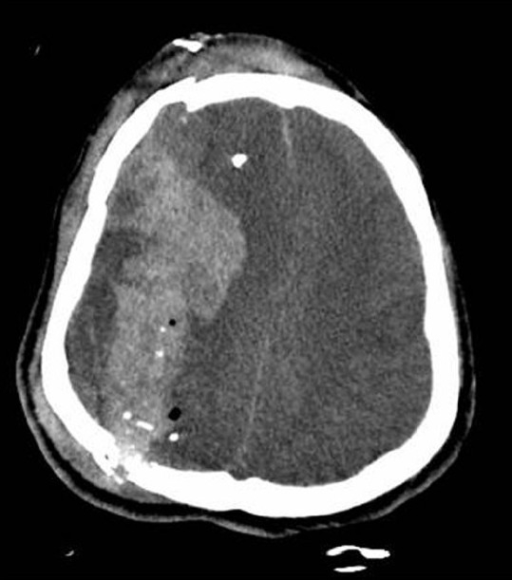Playlist
Show Playlist
Hide Playlist
Head Trauma: Introduction and Diffuse Axonal Injury
-
Slides Head Trauma.pdf
-
Download Lecture Overview
00:01 So let's learn a little bit more about brain injury and head trauma. 00:05 And we'll start with a definition. 00:07 Head trauma is an injury to the skull, brain and/or intracranial structures and that may be with or without hemorrhage, it's just an injury. 00:17 In terms of epidemiology, brain injuries are extremely common with greater than 75,000 deaths in the United States, secondary to traumatic brain injuries of some kind each year. 00:30 There's an increased risk in men and there's a bimodal distribution. 00:34 We see this in young children likely related to falls trauma, sports-related injuries and those sorts of things and then increasing incidence in the elderly as a result of falls. 00:47 In terms of etiology, there are three things that I think about in terms of causes of brain injury. 00:52 The first is a fall. 00:54 Second is motor vehicle accidents. 00:57 And then the third is sports-related injuries, concussion and other traumatic brain injuries. 01:05 What areas can be impacted in the brain and skull and head as a result of a brain injury? We can see skull based fractures, which are extremely concerning and need to be managed. 01:17 We can see associated facial injuries, lacerations, ecchymosis or bruising. 01:22 And patients with these injuries will be high risk for airway compromise or cranial nerve injury or other secondary deficits. 01:30 We can see scalp lacerations that point to an area of potential underlying injury and need to be managed outright, and then the potential for an underlying injury needs to be evaluated. 01:42 And then we can also see injuries within the brain itself. 01:45 And we divide those into focal brain injuries, like contusions or bruises on the brain and intracranial hemorrhages, and then more diffuse brain injuries. 01:53 And concussion or traumatic brain injury is a diffuse brain injury as a result of some type of traumatic injury. 01:59 And then diffuse axonal injury, which is a more severe form of neural injury as a result of trauma. 02:09 What about the pathophysiology? What's going on in the brain as a result of a brain injury? And I like to divide this into the primary injury to the brain, and then potential secondary injuries that can occur because of the inflammatory response or biochemical changes that occur after an injury. 02:26 So in terms of the initial insult, the primary injury this occurs at the moment of the injury, at the moment of the fall, or as a result of the impact from the motor vehicle accident, or from the sports-related fall, hit or injury with a sporting event. 02:42 When we think about these, we can have a number of different types of injuries that can occur on the brain. 02:47 Acceleration-deceleration injuries or abrupt movements and with deformation of the brain, and the cranial cavity that results in a traumatic injury to the brain. 03:01 And then we can see coup/contrecoup injuries where the brain will initially have an impact that results in initial coup injury, and then is tossed backwards or sent backwards, and we can see injury on the opposite side of the brain or a contrecoup injury. 03:17 We can also see secondary injuries that develop after the initial traumatic event. 03:21 These are injuries that occur hours, days or sometimes weeks after the initial trauma. 03:26 This results from the body's response to the original trauma, inflammation or changes in biochemistry or electrolyte disturbances that contribute to secondary injuries after the initial trauma. 03:38 Molecular injury mechanisms include inflammation, apoptosis, or cell death, secondary ischemia or reduced perfusion, a number of mechanisms of the secondary injuries. 03:49 And this can result in local or diffuse brain edema, either as a result of hemorrhage or increase in intracranial pressure. 03:57 And we really worry about the secondary injuries in patients who have suffered an initial traumatic brain injury. 04:05 And eventually these may eventually lead to coma, death or long term irreversible neurologic dysfunction. 04:13 So what types of brain injuries do we see? I want you to think about two broad categories for brain injuries, there are open and closed brain injuries. 04:24 The open brain injuries are those that are penetrating. 04:26 So here the injury involves a some penetration of the skull, dura mater or fracture of the calvarium. 04:33 So there's an open injury where the brain itself is exposed in some way. 04:39 Brain tissue is directly injured by fragments, often of bone or other objects, bullets, knives or anything that has penetrated the skull. 04:48 We can also see closed head injuries. 04:51 These are more common than the open injuries. 04:53 We see that the cranium is intact, the dura mater is intact and there's an injury to the brain underneath. 04:59 The brain is damage due to the acceleration-deceleration or rotational forces that occur as a result of the trauma. 05:07 And these can be focal or diffuse. 05:12 And one of the things that I want to draw highlight too is diffuse axonal injury. 05:16 This is the most severe form of diffuse injury to the brain as a result of a brain trauma. 05:22 Diffuse axonal injury as it's described is injury to the axons of the nerves caused by shearing, stretching injuries to the axons, or neurons as a result of rotation or severe acceleration-deceleration. 05:38 We often see evidence of axonal diffuse axonal injury at the gray white junction, often occurring at that area that between the gray and white matter, and that's an area of potential stretch of the neurons. 05:52 Traumatic injury causes disruption of the cytoskeleton of the axons in those areas. 05:56 The cell bodies are anchored in to the cortex and the axons move resulting in a shearing injury that can lead to injury of the axon, swelling and damage to the neurons. 06:08 We see diffuse axonal injury on imaging, and it's indicative of a wider spread and more diffuse injury to the brain broadly. 06:18 And here's a nice case to show an example of the types of traumatic injuries. 06:21 We can see both focal and diffuse. 06:25 This is a case of a 27 year-old pedestrian who was struck by a motor vehicle and we're looking at a series of MRIs. 06:32 On the left, we have the diffusion weighted image. 06:34 And this shows us area of cytotoxic edema, cells that are swollen because of loss of the sodium potassium ATPase, they're injured, and that injury shows up as white areas on the diffusion restricted diffusion. 06:48 And you can see on the left, multiple small punctate foci of restricted diffusion that is at that gray white junction the area that is at risk of for diffuse axonal injury. 07:00 In the middle, we see a T2 weighted image showing a lesion deep within the caudate body and the basal ganglia with a fluid level. 07:08 This is an area of hemorrhage as a result of a subcortical contusion likely from this traumatic injury. 07:14 And then on the right, the susceptibility weighted image shows an area of hemorrhage and so we see both focal brain injury in this patient as well as more diffuse axonal injury both of which can occur from a trauma. 07:30 Diffuse axonal injury again to reiterate, is a definitive diagnosis is made only at autopsy. 07:38 Clinical diagnosis is made in patients who have a severe TBI, often with a Glasgow coma scale of less than 8 for a prolonged period of time. 07:48 Management is geared towards preventing secondary injuries such as hypoxia, intracranial, hypertension or hypotension and elevated intracranial pressure. 07:58 We're trying to create a favorable environment for the brain to heal after this axonal injury reducing biochemical stress, reducing biochemical demand on the neurons. 08:10 Timely high level resuscitation and close monitoring are required for these patients.
About the Lecture
The lecture Head Trauma: Introduction and Diffuse Axonal Injury by Roy Strowd, MD is from the course Head Trauma.
Included Quiz Questions
Head trauma is...
- ...an injury to the skull, brain, and/or intracranial structures.
- ...ischemia to brain tissue.
- ...a physical force applied to the cranial structures resulting in hemorrhage.
- ...any nonhemorrhagic injury of the brain tissue.
- ...an injury to the skull but not the deeper structures.
What is one of the three most common etiologies of head trauma?
- Falls
- Gang violence
- Inadvertent trauma in unobserved children
- Helmet-induced trauma
- Airbags
What is an example of a diffuse brain injury?
- Diffuse axonal injury
- Contusion
- Intracranial hemorrhage
- Scalp laceration
- Basilar skull fracture
What is the term for a primary brain injury affecting a focal area of the brain on the side of impact and also the opposite side of the brain?
- Coup and contrecoup injury
- Diffuse axonal injury
- Acceleration/deceleration injury
- En coup de sabre injury
- Subdural hematoma
What term describes a diffuse injury to the brain caused by shearing or stretching forces on the axons of the brain parenchyma?
- Diffuse axonal injury
- Subdural hematoma
- Diffuse neuronal shearing
- Generalized neuronal injury
- Hemorrhagic infarct
Where in the brain is diffuse axonal injury most likely to occur?
- Junction of the gray–white matter
- Basal ganglia
- Corpus callosum
- Pyramidal nuclei
- Internal capsule
Customer reviews
5,0 of 5 stars
| 5 Stars |
|
5 |
| 4 Stars |
|
0 |
| 3 Stars |
|
0 |
| 2 Stars |
|
0 |
| 1 Star |
|
0 |




